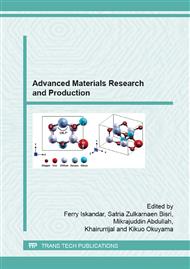p.397
p.402
p.406
p.410
p.414
p.421
p.425
p.429
p.433
Characterization of Chitosan-Acrylamide Hydrogels as Soil Conditioner
Abstract:
Hydrogels can be used as soil conditioner which acts as water reservoirs and release water depending upon the need of plant roots. Soil conditioner based hydrogels were synthesized by graft copolymerization of chitosan-acrylamide using gamma irradiation. In this research, the influence of hydrogels amounts on physical, and chemical properties of the sandy soil characterization were investigated by measuring bulk density of soil, porosity, water retention, and field capacity. Bulk density of the soil was decreased, whereas water retention and porosity were increased with increasing additions of hydrogels. The addition of 0.4% hydrogels increased the field capacity significantly. Biodegradation studies of the hydrogels were carried out by soil burial-test in a composting environment up to 6 weeks. Microscopy analysis shows structural deformation of hydrogels with time. Hydrogels show sharp weight loss until 4 weeks. Soil conditioner based chitosan-acrylamide hydrogels was found to be beneficial for maintaining the physicochemical soil properties as well as plant growth.
Info:
Periodical:
Pages:
414-417
Citation:
Online since:
July 2015
Authors:
Keywords:
Price:
Сopyright:
© 2015 Trans Tech Publications Ltd. All Rights Reserved
Share:
Citation:


